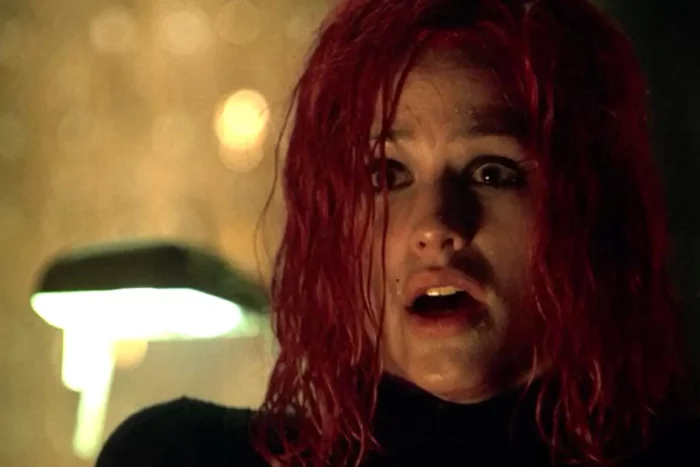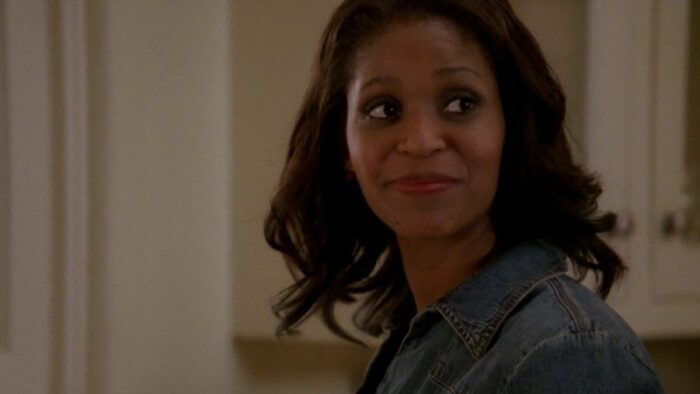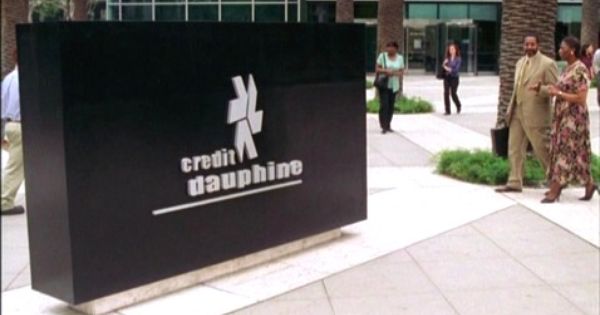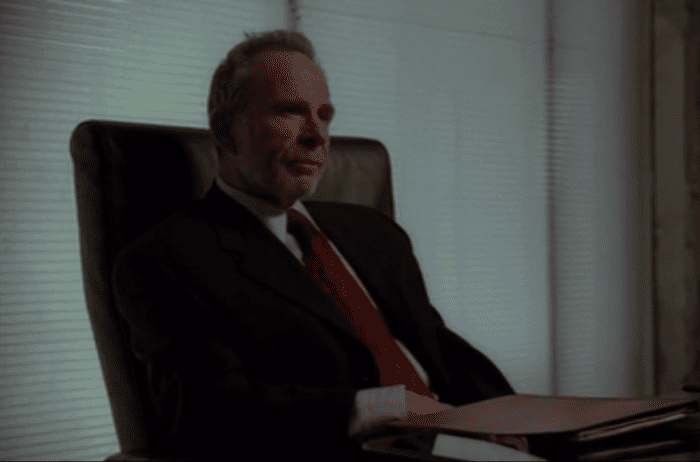The following contains spoilers for Alias S1E1, “Truth Be Told” (written and directed by J. J. Abrams)
It is easy to forget, for all the subsequent success with the Mission Impossible, Star Trek and now Star Wars mega-franchises, that the pilot episode of ABC’s Alias remains one of the best things producing and show-running supremo J.J. Abrams has ever done. “Truth Be Told” is a blistering 65 minute opening to a rare TV show—one which comes on the face of it fully packaged, fully formed, and with a confidence and spring in its step that belies its quiet, low-fi origins. There is more to this package, and how it was created however, than meets the eye.
Think back to 2001. Had anyone heard of Abrams at that point? He was established—a proven Hollywood screenwriter with credits such as Michael Bay’s Armageddon or Harrison Ford vehicle Regarding Henry, not to mention four seasons of teen drama Felicity as a showrunner. Those movies were nonetheless famous for their stars and directors, not the glasses-wearing megamind of Abrams bashing away at the words, and Felicity was never particularly that big of a hit—I’m not sure it ever even aired in my native UK, and if it did it went largely unnoticed. Alias was the series which put Abrams, and most of his writing staff, on the map.
The first season of his spy drama races out the gate with fast-paced, stylish storytelling, which crucially never forgets to place character at the heart of every beat, every scene and every plot-twist. “Truth Be Told” is B-movie, pulp action with significant heart and soul. That description could characterise Alias in general, in many ways. Abrams starts his story in media res, to quote the Latin; the narrative flashing-forward, introducing us to our protagonist Sydney Bristow, and our star Jennifer Garner, in a deadly situation—captured, speaking in Mandarin, already beaten up, and awaiting some kind of awful horror behind the door of the dingy room she is being held in.

Abrams would repeat this opening, with a few tweaks, for his breakthrough onto the big screen in Mission Impossible III, which is essentially the same plot line as the pilot for Alias; indeed Tom Cruise hired Abrams to helm the third film of his franchise on the back of Alias, by that point heading toward its concluding season. “Truth Be Told” has a confidence in how to introduce Sydney and her world which pays dividends for Alias as a whole, and will pay dividends later for Abrams’ own career.
Not that this came naturally to Abrams, as he confided to Mark Cotta Vaz in Alias Declassified: The Official Companion:
It’s funny, because the pilot felt like driving in the fog. We were starting up the car and in the distance you could see, barely, the shape of this mountain you’re going to be heading towards. The whole season was driving through this fog where, as you went along, you started seeing details you couldn’t see at first. And we couldn’t anticipate all the turns we had to make to reach that mountain.
On the back of “Truth Be Told,” you can understand what Abrams is driving at here. While the pilot introduces a raft of elements which will carry across the entire run of Alias, from narrative points to character aspects, there remains a feeling of experimentation when it comes to what Abrams is doing. He has, as he states, that rough idea of the tone, feel and texture of the show, but the pilot is testing the water in precisely where that goes.
One aspect you notice with “Truth Be Told,” which steadily begins to rescind as the season progresses, is just how much of a preppy, late 1990s overhang the whole thing has; be it in the classical American college environment Sydney studies in, to Abrams layering the soundtrack with grungy ’90s ballads, and without question the sparky, happy relationship Syd has with her fiancee Danny (Edward Atterton)—his proposal is straight out of 10 Things I Hate About You.
Yet the show doesn’t feel rooted, even in the pilot, in ’90s storytelling. If it resembles anything in tone and style from that decade, it would be Buffy the Vampire Slayer; characters occasionally drop in pop-culture references, Abrams throws in one-liners, dry sarcasm, and there is even a balance between older and younger characters, not to mention characters who both exist in the real world and the world of espionage, which is equivalent to the supernatural world of monsters Buffy inhabits, looking at the show in mythological terms.
Take a character like Francie Calfo (Merrin Dungey), who in this analogy operates the same function as Buffy’s mother Joyce; she is a normal person living with someone living an extraordinary life, but who has no idea about the other side of the curtain. Abrams therefore layers in a multitude of familiar storytelling aspects while calling back to the pace, joie de vivre and cartoonish melodrama of the 1960s TV shows Alias taps into from a retro-futurist perspective.

What the show doesn’t really have space to do in the pilot is flesh Francie out with any particular character depth, and you can already sense she may become a storytelling problem as the series will progress. Everyone else in the pilot provides an understandable function—Dixon is the partner, Sloane the boss, Will the lovelorn best friend etc.… but aside from being the flatmate, Francie doesn’t really have any definition by the end of “Truth Be Told,” at least not in the same manner as everyone else at this early stage.
She also feels keenly tuned into the ’90s overhang by being a black character who never seems particularly in tune with black culture; you feel Merrin Dungey wasn’t essential casting, that the role as written could easily have been a white actress. Alias deserves props for attempting to display a normalised interracial friendship on screen but it never feels interested enough to take it further. Aside from ’90s nostalgia, Abrams also introduces something he will play with a great deal more as Alias progresses, and further in his career (particularly in his next TV show, Lost): the mystery box. Abrams goes into detail on this concept in a wonderful TED talk, tracing back his love of mystery in storytelling and how it often fuels and drives how he approaches narrative:
I was trying to think, what do I talk about? Good question. Why do I do so much stuff that involves mystery? And I started trying to figure it out. And I started thinking about why do I do any of what I do, and I started thinking about my grandfather. I loved my grandfather. Harry Kelvin was his name, my mother’s father. He died in 1986. He was an amazing guy. And one of the reasons he was amazing: After World War II, he began an electronics company. He started selling surplus parts, kits, to schools and stuff. So he had this incredible curiosity. As a kid, I saw him come over to me with radios and telephones and all sorts of things. And he’d open them up, he’d unscrew them and reveal the inner workings—which many of us, I’m sure, take for granted. But it’s an amazing gift to give a kid. To open up this thing and show how it works and why it works and what it is. He was the ultimate deconstructor, in many ways. And my grandfather was a kind of guy who would not only take things apart, but he got me interested in all sorts of different odd crafts, like, you know, printing, like the letter press. I’m obsessed with printing. I’m obsessed with silk-screening and bookbinding and box making. When I was a kid, I was always, like, taking apart boxes and stuff.
Eagle-eyed readers and fans of Star Trek will recognise the significance of his grandfather’s surname (that’s another story…) but Alias, right from the get go, roots itself in a sense of narrative mystery it consistently builds into its mythology. We will see this more directly with the Rambaldi mythology to come, but “Truth Be Told” taps into these aspects at various points: the terror in that first scene of what lies behind that door in the room Syd is captured in; the enigma surrounding her father Jack and precisely whether he is a good guy or bad guy; and even down to the more mundane plot aspects of precisely what the Mueller Device ‘MacGuffin’ is and what it does. Abrams opens his mystery box with this first episode of Alias and, in all honesty, he hasn’t closed it since, no matter what he has gone on to do.
“Truth Be Told” also has a defined sense of visual style, which comes across in how Abrams manages to design the aesthetic of the world in Alias. The core idea of SD-6, a fake American black ops agency hiding behind a corporate structure named Credit Dauphine, is presented in grungy, stripped back tones, as if the agency are inside a warehouse and could pop up out of nowhere and disappear into the background just as easily—an agency hiding in plain sight, which is appropriate given what Syd discovers about them as the story unfurls. It feels oddly post-modern, hi-tech but in a less overtly futuristic manner than intelligence agencies in cinema (such as True Lies, for example) would present a covert ops agency.

In contrast, as production designer Scott Chambliss states in Alias Declassified, when Syd enters the real CIA, it is intentionally presented in more of an old-fashioned stance:
While SD-6 would be super sleek with very advanced technology, we wanted to create a CIA environment that reinforced the idea of governmental bureaucracy. Our CIA was definitely not going to be a hip place, but we didn’t do a Doctor Strangelove on them. The CIA today is very ’80s industrial park and utterly bland, but we gave it the retro personality of the CIA from the 1950s and ’60s.
This is a significant nod toward the retro-futurism I mentioned earlier, the idea that Abrams stylistically and creatively with Alias wanted to borrow from the kind of escapism he grew up watching as a child in the 1970s, enjoy re-runs of The Man From U.N.C.L.E., or Mission Impossible, and of course James Bond—a very clear and key influence on Alias. The Marshall Flinkman (Kevin Weisman) character is, without question, a modern day version of Bond’s Q character, doling out advanced and quirky gadgets to Syd but, again, with a post-modern spin on the character. Whereas Q was cranky and disapproving to Bond, here Marshall is geeky, talkative and eager to please the cooler super-spies with his innovations. It’s interesting how the modern Q in Daniel Craig’s films feels shabbier and more awkward in the Marshall sense as Ben Whishaw, as if Marshall is more suggestive of modern, or post-modern, geek culture than the traditional quartermaster.
Weisman recounted quite an amusing anecdote in fact about quite how he styled Marshall, and who on:
I was 29 at the time, and Marshall was described as mid-40s, overweight, balding with a ponytail and a Mötley Crüe T-shirt. And I was like, “What? I just worked with J.J. [on Felicity]. Are you sure they want to see me?” …And so, we tried it a bunch of different ways. I tried Marshall super confident and then super laid back, cocky, highly intelligent… I never told [Abrams] ’til years later. I was like, “You know, I kind of based it on you.”
Aside from Marshall and the clear Bond homage of his character, it’s also notable that Abrams casts the over-arching villains, the Alliance of 12, as a modern-day SPECTRE organisation. They are only mentioned here in passing by Jack Bristow (Victor Garber) to define the bigger threat behind SD-6, defined by him as “a pool of agents who went freelance,” but through these Bond-esque villains we will come to see more in future episode, Abrams is able to re-create the kind of escapist enemy American audiences needed in the post-9/11 world Alias arrived into. In many shows, and everywhere in the news, America was facing a new threat in the terrorist face of the Taliban and Osama bin Laden, but Sydney would be working to destroy the enemy within being controlled by a broader, shadowy cabal. This could ironically have been what prevented Alias being a truly breakout television hit at the time.
In the end, the reason “Truth Be Told” works is because of character. While Abrams establishes a world with interesting production design and seeds of a mythology which will enrich the show (even if it’ll also confuse and hamper it), Alias arrives well-packaged because the characters are, already, so well-drawn. Sydney Bristow really should be more of a signature face in popular culture; an all-American action heroine, she takes a cue from legendary female spies such as The Avengers’ Emma Peel, video game stalwarts like Tomb Raider’s Lara Croft, or cinematic icons like Aliens’ Ellen Ripley. She is feminine, strong, vulnerable and sympathetic all at once, not to mention capable of effortless cool, and a great deal of that is down to the immediately likeable performance of Jennifer Garner, another breakout face and name from the series.
“Truth Be Told” really puts Sydney through the emotional wringer; she loses the man she loves, finds out her father has been a spy all along, and discovers she has been working, as Jack puts it, “for the enemy you thought you were fighting.” In just over an hour, Sydney is well-established as a woman who makes a terrible mistake that ends up with her fiancee dead and her life changing significantly, while introducing a range of impressive supporting players in her wake. You get an instant sense of Jack, for example, in the brilliantly-written first moment when Danny asks him for Sydney’s hand in marriage. “Welcome to the family” might be the line of the episode. Victor Garber instantaneously reveals a hard-hearted man on the outside concealing a dry-witted, deeply caring man within, one who we’ll see is riven with a haunting level of tragedy the show plays out beautifully across the five years.

What Abrams does well in “Truth Be Told” is establish that Alias is really about this father-daughter relationship, and how it evolves within the highly-covert world of espionage Sydney and Jack inhabit. The show will built on the ‘family’ aspect within the Alias team of characters, and it will try and convince us the series is really about the romantic entanglement between Syd and her handler we meet at the end of the pilot, Michael Vaughn (Michael Vartan), but the truth is the heart of Alias is Syd & Jack. That’s what means the most in “Truth Be Told” and it’s what packs the biggest punch in series finale, “All the Time in the World.” “I guess we’ll just have to trust each other,” Jack’s final line, could be a thought that carries across the entire series.
Other characters, we get an impression of to be built on across the season. Marcus Dixon (Carl Lumbly) instantly comes across as seasoned in his role, even a bit cranky about modern technology, but he and Syd instantly have an enjoyable big brother-little sister vibe to their relationship; Marshall, as we have discussed, begins much like a post-modern trope, but plenty of engaging shades will be added to the guy beyond just comic relief in time; Will Tippin (Bradley Cooper) is nicely set up as the complication in Syd’s personal life, visibly a man in love with her and struggling with the idea she may get married, but he also feels like Abrams testing the water with him being the pop-culture cipher. The writing for a nascent, pre A-list Cooper never really allows Will to go down this road, with Abrams more having Will follow an All the President’s Men journey, but it is one of Alias’ greatest ironies that the character least well-served by the series would be played by its most successful actor in future by far.
Arvin Sloane (Ron Rifkin), of course, will go on to be the show’s primary antagonist, so it’s intriguing just how low-key Rifkin plays him across much of “Truth Be Told.” Sloane is a small, aged, almost certainly Jewish man, and on the face of it does not drip menace, indeed here Sloane feels positively corporate himself in a role which often is largely expository as the traditional boss character. He doesn’t even display the level of interest he will later show in the Rambaldi mythos, almost certainly because at this stage Abrams and his writers hadn’t quite figured out the connections between Sloane and the underpinning mythology. Sloane seems almost disinterested in describing dead scientist Oskar Mueller as a “modern day alchemist,” but then Mueller seems very much like a prototype for the Rambaldi character to be introduced in the third episode, “Parity.”
It is interesting how Sloane also describes the search for Mueller’s experimental device as between a “frenzy of multinationals,” suggesting more of a corporate company aspect interested in the weird science behind Rambaldi than the show ever really goes down. Sloane mentions FTL, one of the enemy espionage agencies the series will have chasing Rambaldi alongside SD-6, but the idea corporate entities are after this mysterious technology feels like yet another idea Abrams is throwing at the wall to see if it sticks. Sloane describes Mueller’s writing as demotic, not hieratic, as Syd guesses, and says that “taking notes in ancient languages is one of Mueller’s quirks.”
This, again, feels suggestive of bigger mythological ideas Abrams is flirting with:
You always have ideas of where you would like it to go. And [the Rambaldi plot] was something I wanted to do from the very beginning. I purposely, in the pilot, didn’t have her stealing a disc or a computer chip or a data device, because I didn’t want it to be just that. I wanted it to be this strange object that you didn’t quite understand. So this thing, the Mueller Device, this weird floating red ball, was the beginning of something that said the show was going to go into areas that would be as much sci-fi as spy. And that horrible “spyfy” moniker got attached to it because of that.
That’s almost surprising, to hear Abrams disliked the ‘spy-fi’ label that Alias was given, precisely because from the off in “Truth Be Told” you do sense the show is teetering on the edges of storytelling which will be less conventional than other spy shows such as, say, 24, or on the other side of the Pond, Spooks aka MI:5 (as it’ll be known in the States). Just look at Ric Young’s quietly menacing villain, known only here as ‘Suit and Glasses’—he is straight out of a Bond film, one of those terrifying torturer figures working for a much bigger super-villain, with a particular set of skills. “I have nothing left to lose,” Syd boasts. “That’s not exactly true,” he replies. “You have teeth.” These are not bad guys in the modern day sense but another nod to the retro-stylistics of Alias, in which henchmen were disposable goons and bad guys had flavour, character and enigma.

There is a sense of foreboding about “Truth Be Told” because of that character, actually. Abrams starting in media res and returning repeatedly to the torture we know Sydney will experience threads the piece with an ominous understanding that everything in her life is going to fall apart. It’s very interesting how Syd’s choices are the reason they do, as well. Granted, had she not have been working for an evil, global crime syndicate, chances are telling Danny she was a spy wouldn’t have seen him murdered in cold blood, but she still breaks rules she knows she shouldn’t break. A lot of this comes from a place of loneliness, a place Syd will fight against across the show: “I didn’t feel like I fit in, even in college,” she explains, which hints at deeper revelations about her past and her family, but speaks to her psychology.
Syd tells Danny the truth because he’s planning a future with her and she cannot bear to lie to him for the rest of it, but equally that compulsion to save lives and do the one thing she is truly good at means she can’t just quit. It’s interesting how Dixon sees it differently in relation his wife Diane, who has been in the dark for years: “I am protecting her from the truth,” he rationalises it, that this is the one rule you don’t break. It’s even more powerful as a viewer when Dixon has to tell Diane in Season 2 when his own world falls apart. Syd nonetheless suffers the consequences of her risk, to try and live a life without secrets, and even Danny is fine with it: “I don’t care. The whole world’s a nightmare anyway.” Given this episode aired less than three weeks after 9/11, this reaction feels even more acute and timely, as do the big surveillance aspects involved in his murder.
We see satellites working. Phones tapped. Surveillance of the 21st century where privacy laws are being eroded, and 9/11 will only see a massive increase in the monitoring of American citizens in the reaction to modern terrorism. The fact Danny is killed so quickly as a result of this, especially by the sinister enemy within, the externalisation of an American fear which goes right back to the Cold War days of the ’50s and ’60s that Alias stylistically is playing off, is particularly ironic. Abrams frames this against more of those retro-trappings; juxtaposing Danny’s drunken call with a ballgown clad Syd, in full Bond mission mode, sneaking into an embassy to do her spy thing while backed by Michael Giacchino’s already impressionistic music… it’s all part of Alias’ already stylish brew. You get the same thing when Syd, under fire by SD-6 agents, calls Francie as part of tricking them. “D’you want to hear about the worst day ever?” It’s a balance of comedy and danger that works really well.
Yet it counterpoints this with the raw pain and horror of Syd finding Danny dead (and Garner’s wonderfully naturalised reaction), or her furious stalking into Sloane’s office ready to rip him apart for an action he doesn’t even apologise for and even suggests she is to blame for, incredulously to her (even if, in part, he’s right). “Truth Be Told” does have moments which emotionally punch you in the gut between all the pulse-pounding action and nifty spy stylistics. Thematically, it all tethers and builds well across the piece, with Abrams squeezing whatever drop of emotion out of a well constructed script in order to get Syd from a happy woman with a double life, to a tragic widow about to become a double agent. Abrams breaks her down in order to set her up with the ‘alias’ she will need to take down that enemy within.
Alias, therefore, delivers with a first episode which superbly establishes both the cast and narrative structure of a show which will, right from the off, attempt to pull a trick many other series would baulk at—long-form, serialised storytelling with regular, daring cliffhangers and a sense of momentum building to bigger personal revelations. “Truth Be Told” proves J.J. Abrams has a rare gift for telling a thrilling story, with an instant sense of world-building and mythology, while rooting it inside character and emotion.
There is lots more to be explored as we head into Season 1 but, as the show makes clear, truth takes time…

